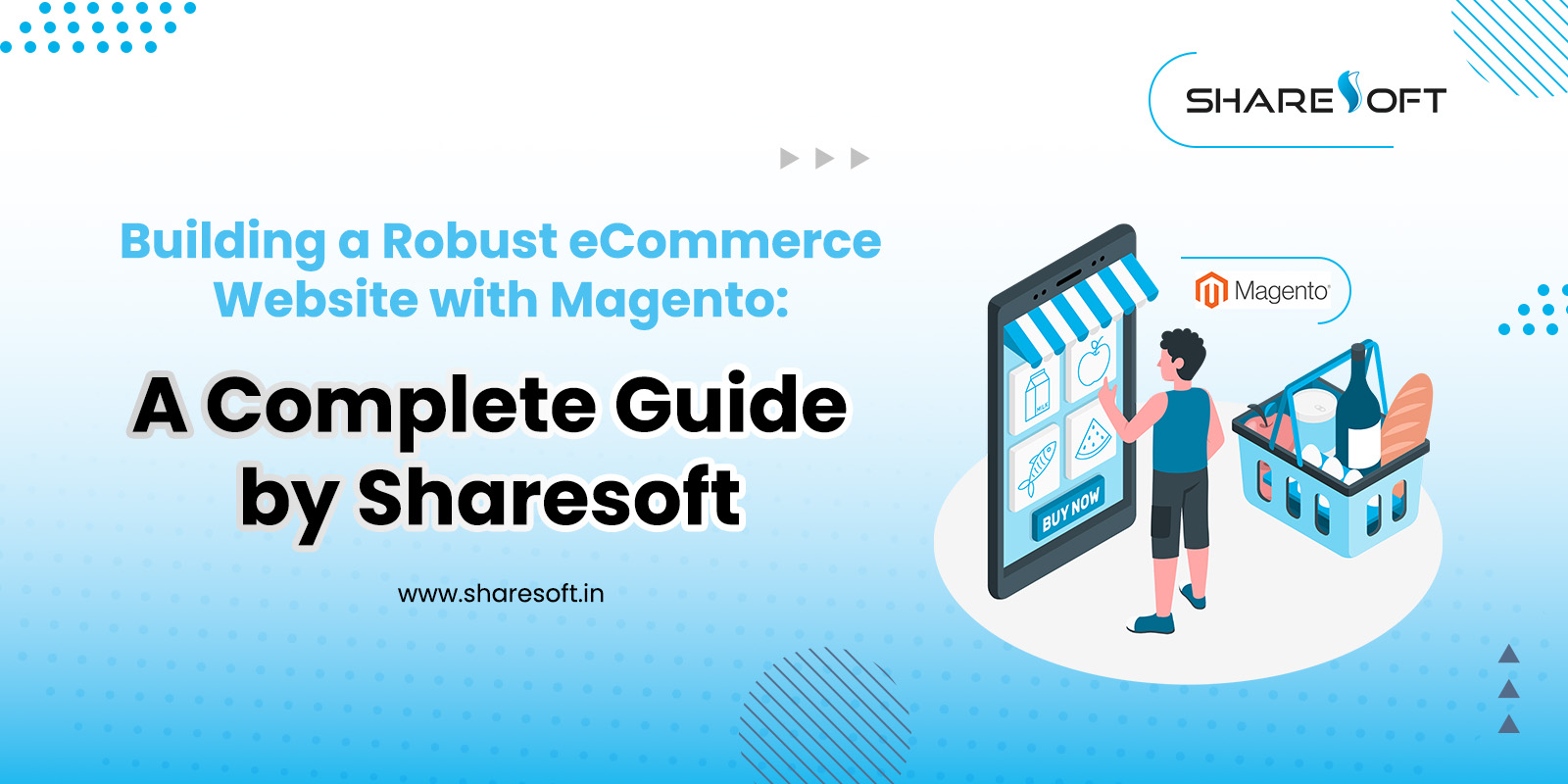
Latest Blog
In today’s fast-moving digital world, building a strong online presence is more than just having a website — it’s about creating a seamless, scalable, and high-performance eCommerce experience that engages customers and drives revenue. For enterprises and ambitious eCommerce companies, Magento stands out as one of the most powerful frameworks for creating advanced, customizable online stores.
At Sharesoft, we specialize in helping brands harness the full potential of Magento to create eCommerce platforms that don’t just look good, but perform exceptionally well under real-world business demands. This guide walks you through every step of building a robust Magento-based online store — from planning to launch and beyond — while explaining how to make it SEO-friendly, scalable, and future-proof.
Understanding Magento: Why It’s the Backbone of Modern eCommerce
Magento, now officially known as Adobe Commerce, is an open-source eCommerce platform trusted by global brands like Nike, Ford, and HP. Unlike plug-and-play website builders, Magento is built for flexibility and performance.
Key Advantages of Magento for Enterprises
-
Unlimited Customization: You can modify almost every element — from the design to checkout flow — to match your brand’s identity.
-
Scalable Architecture: Whether you’re managing 100 or 100,000 products, Magento handles complex product catalogs efficiently.
-
Multi-Store Capabilities: Run multiple storefronts from one backend, making it ideal for global enterprises.
-
Advanced SEO Settings: Control meta data, URLs, canonical tags, and structured data to optimize visibility.
-
Robust Integration Options: Connect easily with ERPs, CRMs, payment gateways, and marketing tools.
-
Security and Compliance: With regular updates, Magento maintains top-tier data protection and PCI compliance.
For companies aiming for long-term growth, Magento offers the technical foundation to innovate freely and expand effortlessly.
Step 1: Defining Your Vision and Business Goals
Before writing a single line of code, clarity is key.
At Sharesoft, our Magento experts always begin with discovery sessions that define your goals, target audience, and revenue model.
Ask yourself:
-
What type of products are you selling?
-
Who is your ideal buyer?
-
Do you plan to scale internationally?
-
What integrations (ERP, CRM, analytics) are essential?
-
How do you define success — conversions, traffic, retention, or brand visibility?
This early stage determines your project architecture, features, and performance priorities. A solid foundation here prevents expensive rework later.
Step 2: Choosing the Right Magento Edition
Magento offers two main versions:
1. Magento Open Source
Free to use and perfect for small to mid-sized stores that require flexibility and control.
2. Adobe Commerce (Magento Commerce)
A paid, enterprise-grade version offering:
-
Advanced customer segmentation
-
Built-in B2B features
-
Visual Page Builder
-
Cloud hosting
-
Performance monitoring and support
At Sharesoft, we help clients choose the best version based on traffic, sales volume, and long-term goals.
Step 3: Crafting a User-Centric Store Design
Your eCommerce website is your digital storefront — and first impressions matter.
A well-designed Magento store focuses on clarity, speed, and conversion.
Key Design Principles
-
Mobile-First Design: More than 70% of online purchases now come from mobile devices.
-
Consistent Branding: Fonts, colors, and layouts should reflect your brand identity.
-
Clear Navigation: Simplify categories and filters to help users find what they need quickly.
-
Frictionless Checkout: Reduce form fields and enable guest checkout for better conversions.
-
Accessibility: Ensure your store meets accessibility standards (WCAG) to reach all users.
At Sharesoft, our UX/UI designers combine creative visuals with data-driven design to deliver experiences that convert visitors into loyal customers.
Step 4: Magento Store Setup and Configuration
Once the design blueprint is ready, setup begins.
-
Install Magento using Composer to ensure version control and scalability.
-
Configure store settings — currencies, tax zones, time zones, and shipping regions.
-
Set up security protocols including SSL, secure admin URLs, and two-factor authentication.
-
Enable caching and performance settings like Redis, Varnish, and CDN for faster page load times.
-
Create user roles and permissions for admins, marketers, and developers.
Sharesoft ensures every Magento installation is optimized from day one — clean code, robust security, and lightning-fast response times.
Step 5: Managing Products and Catalog Architecture
Your product catalog is the heart of your Magento store. A messy catalog leads to poor navigation, slow loading, and low conversions.
Best Practices for Product Management
-
Define clear attribute sets (e.g., size, color, material).
-
Use configurable products for variations.
-
Organize items into logical categories and subcategories.
-
Upload high-resolution images optimized for web.
-
Add detailed product descriptions with keywords naturally included.
Sharesoft’s Magento specialists help structure catalogs for both SEO performance and user experience, ensuring effortless product discovery and smooth backend management.
Step 6: Extending Functionality with Custom Modules
No two businesses are identical. Magento allows you to customize your store with extensions and custom modules.
Popular module categories include:
-
Payment Gateways: Stripe, PayPal, Razorpay, and others.
-
Shipping Solutions: FedEx, DHL, UPS integrations.
-
Marketing Tools: Email automation, push notifications, and loyalty programs.
-
Analytics & Reporting: Google Analytics, Data Studio, or custom dashboards.
At Sharesoft, we develop custom Magento modules to handle unique business needs — from subscription billing to dynamic product pricing and third-party system integrations.
Step 7: Optimizing Performance for Speed and Scalability
Performance can make or break an eCommerce site. Slow load times lead to cart abandonment and SEO loss.
Performance Optimization Checklist
-
Enable Full-Page Caching and Varnish.
-
Use a Content Delivery Network (CDN) to distribute static content globally.
-
Optimize images using modern formats like WebP.
-
Implement lazy loading for product galleries.
-
Minify and bundle CSS and JS files.
-
Use server-side compression (Gzip or Brotli).
Sharesoft’s Magento hosting and development strategies prioritize millisecond-level performance improvements that directly impact conversions.
Step 8: SEO Optimization for Magento Stores
A powerful Magento site needs strong SEO foundations.
On-Page Optimization
-
Write unique meta titles, descriptions, and alt tags for each page.
-
Use SEO-friendly URLs and proper canonical tags.
-
Integrate schema markup for products, reviews, and breadcrumbs.
-
Optimize for Core Web Vitals and mobile responsiveness.
-
Build internal linking between product, category, and blog pages.
Technical SEO Enhancements
-
Generate XML sitemaps and robots.txt correctly.
-
Set 301 redirects for migrated URLs.
-
Avoid duplicate content with canonical URLs.
-
Enable HTTPS everywhere for secure browsing.
At Sharesoft, our Magento SEO team uses advanced analytics, keyword mapping, and AI-powered auditing tools to ensure your store ranks well and sustains visibility.
Step 9: Integrations for Smarter Operations
A modern enterprise store doesn’t work in isolation — it’s connected.
Sharesoft specializes in seamless integrations between Magento and critical business systems:
-
ERP Systems for inventory and accounting (SAP, NetSuite, Odoo).
-
CRM Tools like Salesforce, HubSpot, or Zoho.
-
Payment & Fulfillment Platforms for automation.
-
Marketing Suites like Mailchimp, Klaviyo, or Google Ads.
These integrations reduce manual effort, ensure data consistency, and improve customer satisfaction.
Step 10: Testing, QA, and Pre-Launch Preparation
Before launching, thorough testing is crucial.
QA Checklist
-
Functional testing for add-to-cart, checkout, and payment.
-
Cross-browser and mobile responsiveness checks.
-
Security vulnerability scans.
-
Stress testing under simulated traffic.
-
Data validation for migrated content.
Sharesoft follows a multi-layer testing approach — ensuring that everything from performance to UX is flawless before your store goes live.
Step 11: Launch and Post-Launch Support
Launching your Magento store is just the beginning.
After deployment, Sharesoft monitors server performance, user behavior, and SEO metrics to ensure everything runs smoothly.
Post-Launch Focus
-
Performance monitoring with real-time analytics.
-
Error log tracking and issue resolution.
-
Regular backups and patch updates.
-
A/B testing to improve conversion rates.
-
Continuous SEO audits and link-building.
Our managed Magento support plans keep your store secure, fast, and aligned with evolving trends.
Common Mistakes to Avoid During Magento Development
Even powerful platforms fail when poorly implemented.
Avoid:
-
Ignoring SEO setup early on.
-
Overloading with unnecessary extensions.
-
Neglecting mobile optimization.
-
Weak hosting infrastructure.
-
Poor data migration planning.
Sharesoft’s consulting team helps businesses avoid these pitfalls by designing efficient, future-ready architectures.
Why Choose Sharesoft for Magento Development
Choosing the right Magento development partner can define your success.
Here’s what makes Sharesoft the preferred choice for enterprises:
-
Certified Magento Developers with proven expertise.
-
Custom development solutions aligned to your business model.
-
Data-driven design & performance optimization.
-
Scalable architecture for high-traffic enterprise stores.
-
Ongoing SEO, analytics, and digital strategy support.
We don’t just build stores — we build scalable digital ecosystems that grow with your brand.
Real-World Impact: How Sharesoft Transforms eCommerce
From fashion retailers expanding globally to manufacturers digitizing their B2B sales, Sharesoft has helped dozens of enterprises:
-
Increase conversions through UX redesign.
-
Improve search visibility with structured data and content strategy.
-
Automate inventory and logistics with ERP integration.
-
Reduce bounce rates with page speed optimization.
Our approach blends technology, creativity, and strategy — ensuring sustainable eCommerce success.
Ready to Build Your Magento Store with Sharesoft?
Your eCommerce journey deserves a foundation that grows with your ambitions. Magento offers the flexibility, security, and scalability to help you compete in a global market — and Sharesoft provides the expertise to bring it to life.
Whether you’re starting from scratch or migrating from another platform, our team will help you design, develop, optimize, and maintain a Magento solution tailored to your brand’s needs.
👉 Let’s build your next-generation eCommerce experience together.
Contact Sharesoft today to schedule a consultation with our Magento experts.
Frequently Asked Questions (FAQ) About Magento Development
1. What makes Magento the best choice for enterprise eCommerce websites?
Magento (Adobe Commerce) is built for flexibility, scalability, and high performance. It supports multiple storefronts, large product catalogs, complex integrations, and advanced SEO customization — all essential for enterprise-level businesses. Unlike basic platforms, it gives full control over functionality, design, and scalability.
2. How does Magento compare to Shopify or WooCommerce?
Shopify and WooCommerce are great for startups or smaller stores, but Magento is ideal for enterprises that require deeper customization and control.
While Shopify limits backend access, Magento allows developers to modify code, integrate third-party systems, and manage large-scale inventory. It’s perfect for businesses seeking a long-term, scalable eCommerce solution.
3. Can Magento improve SEO performance for eCommerce websites?
Absolutely. Magento includes built-in SEO features such as customizable URLs, meta tags, XML sitemaps, structured data, and canonical tags.
When optimized by experts like Sharesoft, these tools significantly enhance search visibility, speed, and Core Web Vitals — leading to stronger rankings and organic traffic growth.
4. How long does it take to build a Magento eCommerce website?
The development timeline depends on your project’s complexity.
A standard Magento store might take 8–12 weeks, while enterprise-grade solutions with custom modules, integrations, and design may take 4–6 months.
At Sharesoft, we create clear roadmaps with milestones to ensure on-time delivery without compromising quality.
5. Is Magento suitable for B2B as well as B2C eCommerce?
Yes. Magento supports both B2B and B2C models natively.
It offers features like bulk ordering, custom pricing, quote requests, and multi-user accounts — making it a preferred platform for wholesalers, distributors, and manufacturers as well as consumer-focused brands.
6. What ongoing support does Sharesoft offer for Magento stores?
Sharesoft provides end-to-end Magento support, including version upgrades, bug fixes, speed optimization, security patches, and SEO monitoring.
We also offer 24/7 maintenance packages to ensure uninterrupted performance and long-term growth for your store.
7. Can I migrate my existing store to Magento without losing data?
Yes. Sharesoft ensures a smooth, secure migration process from platforms like WooCommerce, Shopify, or OpenCart.
We use advanced tools and manual validation to preserve products, customer data, SEO URLs, and order history — ensuring zero data loss and stable rankings post-migration.
8. How secure is Magento for large-scale businesses?
Magento provides enterprise-level security, including PCI compliance, data encryption, and role-based access control.
Sharesoft further enhances this with custom firewalls, automated backups, and continuous monitoring to safeguard your eCommerce data and customer information.
9. Can Magento handle high traffic and large product catalogs?
Definitely. Magento’s modular architecture and caching mechanisms allow it to manage millions of SKUs and handle heavy concurrent traffic without slowing down.
Our team at Sharesoft implements scalable hosting and CDN strategies to ensure your store performs efficiently even during peak seasons.
10. How does Sharesoft ensure SEO success for Magento stores?
Our Magento SEO experts conduct technical audits, optimize product metadata, improve site speed, and create structured internal linking.
By combining Magento’s SEO tools with AI-driven keyword analysis, we help businesses dominate organic and AI-driven search results.







